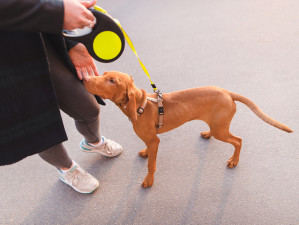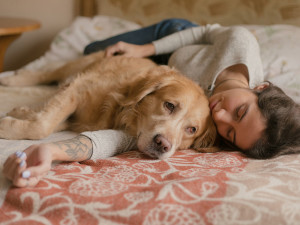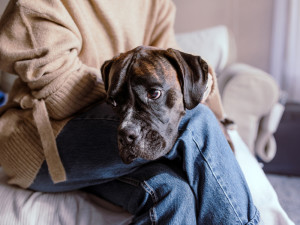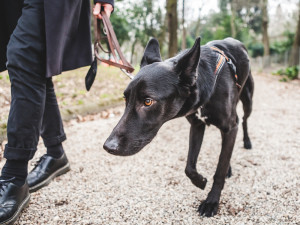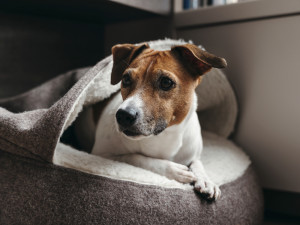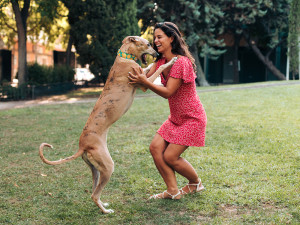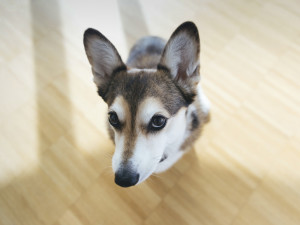Do Small Dogs Pee More Often?
Research shows that little dogs may feel the need to scent mark more frequently than big dogs.
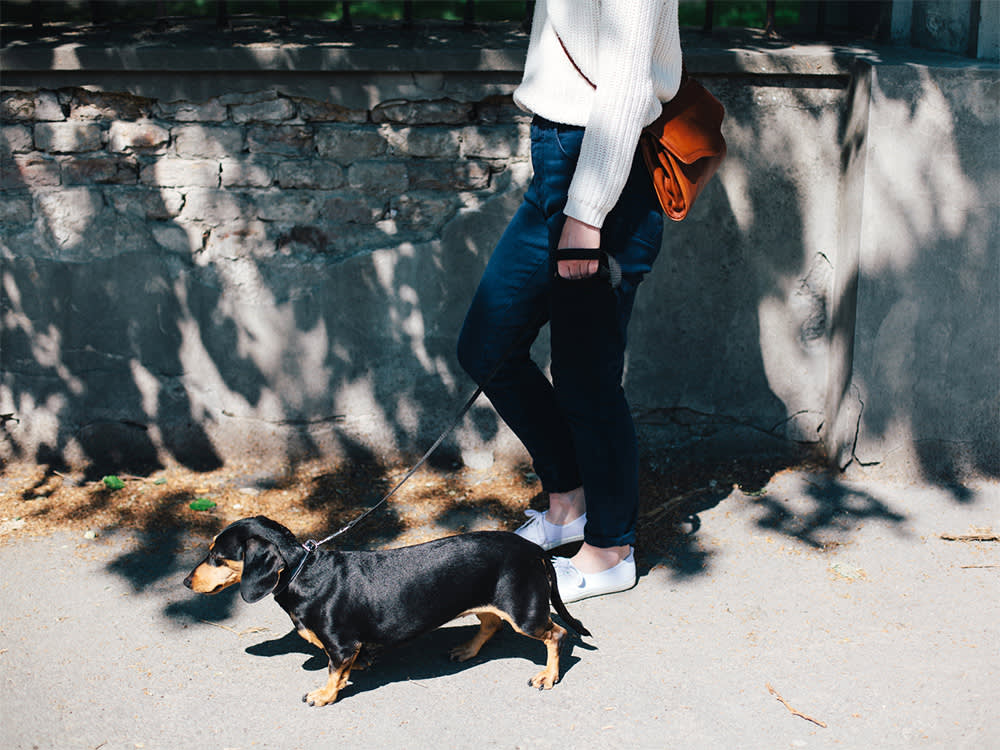
Share Article
OK, here’s one all dog parents will know. Even if you have a puppy, and you’ve been their parent for just a few days, you’ve probably already seen them scent mark. This is when your dog releases a small amount of urine, usually in multiple locations. Marking is a common dog behavior, but if your pup does it often, you might be wondering if that’s normal.
Turns out, lots of dogs do it frequently, but small dogs are most likely to pee often and to scent mark a lot, too. Here’s everything you need to know about the urinary habits of small dogs.

Get (totally free) deals for food, treats, accessories, tech, and way more pet parenting must-haves.
opens in a new tabWhat is Scent Marking?
Scent marking is a common form of communication across a wide range of animals. Although dogs can scent mark in various ways, they most often use urine, which is obvious to anyone who has watched dogs pee here, there, and effing everywhere while out on a walk.
Urination, and other forms of scent marking, allow animals to convey a large amount of information in an indirect manner. In other words, when they mark, they can communicate without direct interactions, which is a good thing because it helps them avoid stressopens in a new tab, the energetic costs of interacting, and potential injury. In many species, body size is closely correlated with competitive ability, which is why scent marking may be especially important to smaller animals, who may be unlikely to fare well in direct encounters.
Do Small Dogs Pee More Frequently?
Dogs have an enormous size range for a single species, but only in the past several years has the effect of size on frequency of scent marking been investigated. Researchers wondered whether smaller dogs take advantage of the indirect nature of scent marking through urine to be more competitive with larger dogs.
Research on shelter dogs found that smaller dogs pee more often than larger dogs do, and males pee more often than females. Additionally, smaller dogs, males, and dogs who have been at the shelter longer all directed their urine at targets more often, meaning they were scent marking rather than just peeing because they had to go.
What factors contribute to small dogs peeing more often?
The authors of a 2016 study opens in a new tabconcluded that smaller dogs use scent marking in the form of urination more frequently than larger dogs. Yes, small dogs pee more often, as most anyone who has lived with both small and large dogs is likely to have noticed, and there are multiple reasons for that.
It’s natural to assume that the small-dog bladder situation at least partially explains why little dogs pee more often, and that assumption is correct. Small dogs can’t store as much urine, so they need to relieve themselves more frequently.
Small dogs have a higher metabolism, so they produce more waste from their energetic ways relative to body size.
Small dogs mark more often, so they are using their urine as a communication method more often than large dogs do.
If the smaller dog is little because they are not yet full grown, their age is another factor. Young dogs usually have to pee more frequently than adult dogs.
Can I help manage my small dog’s urination schedule?
Some dogs, especially small ones, just can’t hold their pee for as long as we’d like. It can be inconvenient, but remember that your dog can’t help it — when you’ve got to go, you’ve got to go. Every dog has an upper limit of how long they can go from one pee to the next, and it’s reasonable to guess they feel pretty uncomfortable if they are always pushed to the edge of that limit.
It’s much kinder to allow them the opportunity to pee more frequently than they absolutely need to. To manage their urination schedule, keep a regular routine of trips outside to pee, and gradually increase the time between outings, but never make it so long your dog can’t hold it or acts desperate to pee.
How many times a day should a dog pee?
There is a lot of variation in how often dogs need to go, just like with people, as anyone who has ever gone on a road trip with a group of friends knows. At the absolute minimum, a dog needs to pee three to four times a day, but many dogs need to go far more frequently. A typical dog needs to go five or six times each day, but up to eight times is far from unusual, and many dogs benefit from an extra chance to go after each meal.
How long can small dogs hold their pee?
As puppies, a general rule is that, at best, they can hold it for no more than their age in months plus one hour, so a four-month old puppy may be able to make it for five hours. That’s only true if they don’t drink a whole bunch of water right at the start of that time period, and they are not playing hard, eating, or chewing on something, all of which can make them more likely to need to go potty. So, this rule means that a tired puppy at rest can make it that long.
Generally, dogs can hold their pee for six to eight hours once adults, but most will naturally pee every four to six hours throughout the day. Most adult dogs can make it eight or nine hours at night without having to go out to relieve themselves, but not all dogs can go that long during the day when they are awake and more active. Senior dogs usually need to go more frequently as they push further and further into their golden years.
Can certain diets or medications help with frequent urination in small dogs?
Medications and diets are factors that can influence the frequency of urination of dogs of any size. In fact, some medications increase the frequency of urination. Any concerns about diet and medication related to your specific dog’s urination frequency should be discussed with your veterinarian.
Frequency of urination is highly individual, so it’s different for each dog. But small dogs (and puppies and senior dogs, too) generally pee more frequently than larger dogs. Their small dog bladders are one reason for this, but a higher metabolism and their tendency to mark more frequently than big dogs are factors, too. Because having a small dog means they need to go out more often, it seems that being a parent to one is the perfect excuse to leave work as soon as possible to get home to them. As if you needed a reason!
FAQs (People Also Ask):
1) How many times should a small dog pee?
It’s common for little dogs to pee at least five times a day and as many as eight times daily is not unusual.
2) Is it normal for small dogs to pee a lot?
Yes, small dogs need to pee more often than larger dogs do, and they also mark more often than larger dogs.
3) Do smaller dogs take longer to potty train?
Smaller dogs often take longer to potty train. They can’t hold it as long, so they are more likely to have accidents.
4) Can I help manage my small dog’s urination schedule?
Keep a regular schedule of trips outside to pee, and gradually increase the time between outings, but not so much that your dog can’t hold it, or seems at all desperate to relieve themselves.
5) What factors contribute to small dogs peeing more often?
The important factors are their small dog bladder, their higher metabolism, their tendency to scent mark more often, and sometimes their age.
6) Can certain diets or medications help with frequent urination in small dogs?
This is a question to discuss with your veterinarian.
References

Karen B. London, PhD, CAAB, CPDT-KA
Karen B. London, Ph.D., is a Certified Applied Animal Behaviorist and Certified Professional Dog Trainer who specializes in working with dogs with serious behavioral issues, including aggression, and has also trained other animals including cats, birds, snakes, and insects. She writes the animal column for the Arizona Daily Sun and is an Adjunct Professor in the Department of Biological Sciences at Northern Arizona University. She is the author of six books about training and behavior, including her most recent, Treat Everyone Like a Dog: How a Dog Trainer’s World View Can Improve Your Lifeopens in a new tab.
Related articles
![Sad boxer rests on owners lap, dog doesn't want to be touched]() opens in a new tab
opens in a new tabHow to Tell if Your Dog Is in Pain
And what to do to help them.
![Shy black dog walking with owner at the park.]() opens in a new tab
opens in a new tabHow to Help an Anxious Dog Conquer Their Fears
Pro tips for boosting the confidence of a scaredy-cat dog.
![A dog looking timid in his bed]() opens in a new tab
opens in a new tabHow to Help Thunder-Phobic Dogs
Tips for comforting your pup when the storm is too loud for your pup’s comfort.
![Portrait of a woman playing and having fun in the park with her big pet, a greyhound dog.]() opens in a new tab
opens in a new tabHow’s Your Dog Feeling? Check Their Tail
If your dog’s tail is wagging “to the left, to the left,” as Beyoncé says, it could mean they’re anxious.
![A dog looking up with a cute face]() opens in a new tab
opens in a new tabHow to Get Your Scared Dog to Trust You
Using these tips, your skittish dog will warm up to you.
